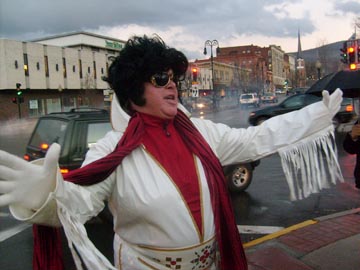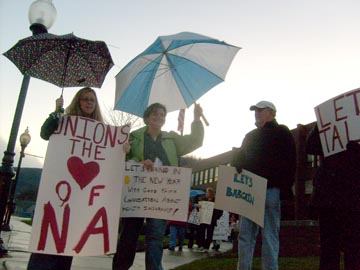
North Adams Unions Protest Failure to Join GIC
 |
And so on Monday night, some three dozen or so members of the city's bargaining units marched around the walkways of City Hall holding signs as the lights in Mayor John Barrett III's corner office glowed above them.
"I've come back for this," said one worker dressed as Elvis and holding a sign with R.I.P. GIC in bold red letters.
The mayor and the city's seven unions have been at loggerheads over the unions' push to join the Group Insurance Commission. The state opened the GIC, which covers some 300,000 state employees, to municipalities two years ago as a way to help lower costs.
It's a matter of putting needed cash back into the pockets of workers while saving the city upwards of $1.5 million, said Brian Kelly, president of North Adams Police Association 382. "We could potentially save $50 a week on a family plan — that's $2,500 a year."
 Monday was the deadline to join the GIC for the next fiscal year. The Police Association is one of seven unions, including the city's largest, the North Adams Teachers Association, that have been lobbying to join the GIC. Their representatives have met with the mayor's office, the City Council and Finance Committee to no avail over the past months.
Monday was the deadline to join the GIC for the next fiscal year. The Police Association is one of seven unions, including the city's largest, the North Adams Teachers Association, that have been lobbying to join the GIC. Their representatives have met with the mayor's office, the City Council and Finance Committee to no avail over the past months."We've expired everything else," said Kelly as workers chanted "GIC, a million bucks for you and me" and the occasional motorist honked in support. "This is a final measure to show what GIC is."
Teachers Association President Christopher Caproni said the unions were still "willing to sit and talk about any insurance ... we really need to talk about insurance in North Adams."
Mayor John Barrett III, not surprisingly, had a different take on the issue.
"We have sat with them, they don't want to hear our figures," said the mayor. The unions' claims of 25 percent reductions in premiums wasn't based on comparable plans offered by the city through Blue Cross Blue Shield, he continued. "You're not comparing apples to apples."
"I am facing a budget deficit next year that could reach a million dollars," he said. "Why in God's name wouldn't I accept a plan that could save us that? ... Because it's not there."
Barrett said he wasn't against the GIC, which already covers the city's retired teachers, but about the timing and the unions' insistence on boosting the city's portion of the premium split from 70 percent to 85 percent.
Sitting behind his desk, the mayor frequently turned to the city's business manager Nancy Ziter for corroboration or correction.
It didn't make sense for the city to enroll in GIC this coming year for a number of reasons, said Barrett, including the thousands it could have cost in "run out," or payment for claims dating back months on the city's self-insured plans. He also pointed to an increase in GIC rates earlier this year, the doubling of GIC costs for retired teachers and the effect on retirees who are now on Medex, a Blue Cross Blue Shield program.
 Both the city and the unions dispute recent insurance options put on the table.
Both the city and the unions dispute recent insurance options put on the table.GIC does not offer Blue Cross; it provides various tiered plans including Tufts,Fallon Community and Harvard Pilgrim.
Caproni and other union officials have stood by a GIC analysis provided by Boston Benefits that touted big savings, although Caproni admitted they would like to see the premium split restructured.
"It is one of the things we've talked about right in the beginning of negotiations," he said. Caproni said the city's split is the highest in the county, which averages 80/20 or little bit more. "We're looking for North Adams to stay competitive with other communities in the county."
The state opened the GIC to civic bodies two years ago as a way to help contain insurance costs. GIC has historically maintained lower rates although many of its plans have higher deductibles and co-pays.
But despite the claimed millions in savings the group can offer, there hasn't been a stampede to join. Some 21 governing entities have or are about to enroll in GIC; of those, only 14 are towns or cities (including Pittsfield). There are 351 municipalities in the state.
GIC is also warning it has to raise premium costs on active workers or sharply boost co-pays and deductibles for all enrollees after Gov. Deval Patrick cut $32 million from its budget.
It takes a 70 percent vote of all governing bodies' bargaining units to join; it also takes that many to get out. Once in, the city would be locked in for three years or six years and the GIC would set the rates; the only option municipalities have is in determining premium splits.
 Barrett called the push for GIC a ploy by the Massachusetts Teachers Association for control because its members would be the determining factor. Rather than protesting about the GIC, they should be protesting the contract offer their leaders rejected, he said. "They are misleading their members."
Barrett called the push for GIC a ploy by the Massachusetts Teachers Association for control because its members would be the determining factor. Rather than protesting about the GIC, they should be protesting the contract offer their leaders rejected, he said. "They are misleading their members."Barrett said the offers for the teachers, police, fire and public works also expired on Dec. 1, and that with looming state and city budget cuts, the "generous offer" was not likely to survive.
"This was about the demise of the GIC, well, they're going to be out there protesting the demise of their salary increase."
Caproni said the unions were willing to work collaboratively with the city to solve the health care issue. "The unions are the backbone of the city and they need insurance relief."
"We are united in what we want is GIC," said Kelly as horns honked behind him. "This is for us but also for taxpayers and retirees."















